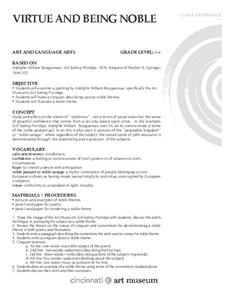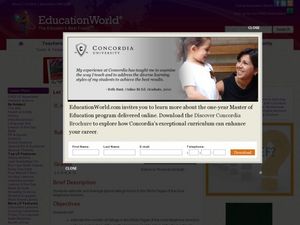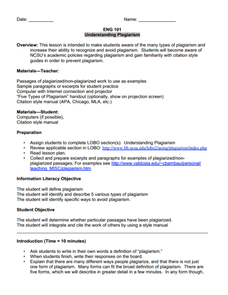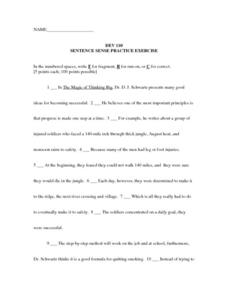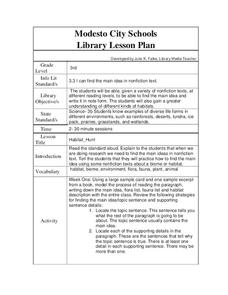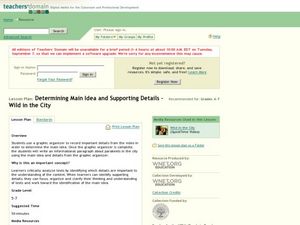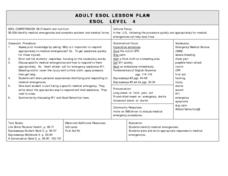Curated OER
Take a Leap!
Eighth graders discuss the flight of the Wright Brothers at Kitty Hawk. They study artwork of various sculptors showing the concept of flight. They write a paragraph and design a papier-mache' sculpture that shows movement.
Curated OER
Virtue And Being Noble
Young scholars write and illustrate original cinquains based upon the ideas of nobility and virtue. The activity includes a vocabulary list of key terms and rubric for student reflection and assessment. This is intended for a 4th through...
Curated OER
Fun With Sun Protection
Students create sun protection devices by modeling sunglasses invented by native people of the Arctic and study about protecting the body from sun exposure. They write a small paragraph explaining and justifying why they believe a...
Curated OER
Librarian, Legacy Keeper
Students brainstorm a list of all the kinds of items kept in a library. They answer questions about the job of a librarian then they write a three-paragraph essay about the work of a librarian.
Curated OER
Let Your Fingers Do the Estimating
Investigate estimation with the White Pages. Youngsters use the phonebook to estimate the average number of phone listings that can be found there. They write a paragraph explaining the processes they used in this challenge.
Curated OER
Fame, Fortune, and Philanthropy
With your middle schoolers, develop concepts such as philanthropy, civic responsibility, community service, and common good. Discuss famous philanthropists and what we can each give of our time, talent and treasure to better our...
Curated OER
Style and Voice
Develop the writing skills of your high school class. Writers consider their personal style and voice, read selections by other authors, and then write pieces that challenge them to experiment with their own style.
Curated OER
Allergy: A Modern Epidemic
In this allergies learning exercise, 7th graders 6 paragraphs about the topic, then answer 12 questions about the passage, complete a table with verbs and nouns from the text, work on 12 sentences and discuss 4 questions with a partner...
North Carolina State University
Understanding Plagiarism
Introduce budding scholars to the many types of academic plagiarism. Potential plagiarizers develop a definition of the infringement and determine how it has been committed. The instructor provides the writing examples and...
Sinclair Community College
Sentence Sense Practice Exercise
Test your learners' skills in identifying complete sentences, fragments, and run-ons with a worksheet challenge. Every sentence from multiple paragraphs is under question, and pupils have to decide if each sentence is a...
Curated OER
New York State Testing Program: English/Language Arts Book 2, Grade 3 2010
This 3rd grade English/Language Arts standardized test practice worksheet includes multiple choice questions, short answer, and a paragraph to correct. The passage intended for the multiple choise section is not included.
Curated OER
Escribir para Educar
Aligned with the Common Core writing standards, this resource has Spanish language learners create a question, write an explanatory paragraph, and identify the main points. You can either suggest an overarching question for your class to...
Shmoop
ELA.CCSS.ELA-Literacy.RI.9-10.3
Need something for group work, homework, or a way to assess your learners on your lessons for Common Core skill RI.9-10.3? Then you have come to the right place because this multiple choice quiz challenges learners to analyze the...
Curated OER
Creating Life Maps (Elementary, Reading/Writing)
Students create a personal life timeline to better explain how a historical timeline is effective in studying history. They also write a poem about themselves.
Curated OER
Habitat Hunt
Third graders read several nonfiction texts and practice finding the main idea for the text as well as learn about various habitats. In this main idea lesson plan, 3rd graders read several nonfiction texts and make habitat cards....
Curated OER
First and Last Sentences
Third graders discover how to read sentences in a paragraph and know the main idea. In this main idea lesson, 3rd graders read paragraphs, underline the first and last sentences and determine the main idea. Students do guided and...
Curated OER
Topic Sentence
Fourth graders identify the main idea of a sentence using the topic sentence and details of the paragraph. In this main idea lesson plan, 4th graders read paragraphs in the passage Hawaii Quakes, Then Shakes.
Curated OER
Cold and Flu
Students read about colds and influenza while practicing reading techniques.
Curated OER
Determining Main Idea and Supporting Details-Wild in the City
Students discuss the main idea of a story. In this writing process lesson plan, students use a video about parakeets as a tool to find the main idea of a story. After viewing the video, they engage in a discussion about...
Curated OER
My Likes And Dislikes
Students practice conversational conventions when expressing their likes and dislikes, with a partner. Individually, they write a paragraph explaing a tiem when they felt acceptance or rejection.
Curated OER
What's Your Emergency?
Pupils identify different medical emergencies they may encounter. As a class, they discuss ways in which they can deal with different medical emergencies. Students practice responding to medical emergencies by writing a brief paragraph...
Curated OER
Plain Polly: Adding Relevant Details
Students use a stick figure to help them learn to write with details. In this details lesson, students brainstorm details to add to the stick figure 'Plain Polly.' Students then draw stick figures for their own writing and give them a...
Pennsylvania Department of Education
Analyzing Key Ideas and Details in Nonfiction
Students explore nonfiction texts. In this language arts lesson, students read a nonfiction text and make predictions. Students identify facts and opinions in the text and draw conclusions as they read.
Curated OER
Making Predictions by Analyzing Key Ideas and Details
Students make predictions. In this language arts lesson, students read nonfiction texts and make predictions about what they are going to read. Students confirm and revise their predictions as they read the text.

